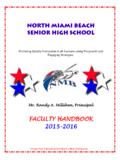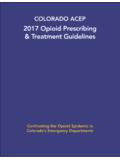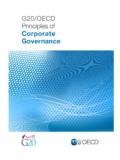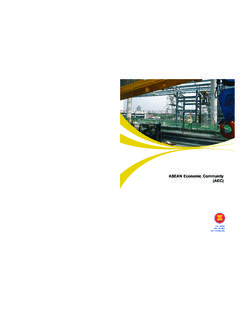Transcription of Voluntary Guidelines to support the progressive ...
1 Voluntary . Guidelines . to support the progressive realization of the right to adequate food in the context of national food security Voluntary . Guidelines . to support the progressive realization of the right to adequate food in the context of national food security Adopted by the 127th Session of the FAO Council November 2004. FOOD AND AGRICULTURE ORGANIZATION OF THE UNITED NATIONS. Rome, 2005. The designations employed and the presentation of material in this information product do not imply the expression of any opinion whatsoever on the part of the Food and Agriculture Organization of the United Nations (FAO) concerning the legal or development status of any country, territory, city or area or of its authorities, or concerning the delimitation of its frontiers or boundaries.
2 The mention of specific companies or products of manufacturers, whether or not these have been patented, does not imply that these have been endorsed or recommended by FAO in preference to others of a similar nature that are not mentioned. ISBN 978-92-5-105336-2. FAO, 2005. FAO encourages the use, reproduction and dissemination of material in this information product. Except where otherwise indicated, material may be copied, downloaded and printed for private study, research and teaching purposes, or for use in non-commercial products or services, provided that appropriate acknowledgement of FAO as the source and copyright holder is given and that FAO's endorsement of users' views, products or services is not implied in any way.
3 All requests for translation and adaptation rights , and for resale and other commercial use rights should be made via or addressed to FAO information products are available on the FAO website ( ). and can be purchased through Y7937E Disclaimer B5 1 27/08/14 1. Foreword In 1996, at the World Food Summit, Heads of State and Government reaffirmed the right of everyone to have access to safe and nutritious food, consistent with the right to adequate food and the fundamental right of everyone to be free from hunger. The declaration of the World Food Summit: five years later, in June 2002, reaffirmed the importance of strengthening the respect of all human rights and fundamental freedoms and invited the FAO Council to establish an Intergovernmental Working Group to develop a set of Voluntary Guidelines to support Member States' efforts to achieve the progressive realization of the right to adequate food in the context of national food security.
4 An Intergovernmental Working Group was established in November 2002 and working relationships, in particular with the Office of the High Commissioner for Human rights and the Special Rapporteur on the Right to Food, were strengthened. After two years of intense and constructive negotiations and discussions among members of the Intergovernmental Working Group and its Bureau as well as representatives of stakeholders and civil society, the Voluntary Guidelines were adopted by the FAO Council in November 2004. The Voluntary Guidelines represent the first attempt by governments to interpret an economic, social and cultural right and to recommend actions to be undertaken for its realization .
5 The objective of the Voluntary Guidelines is to provide practical guidance to States in their implementation of the progressive realization of the right to adequate food in the context of national food security, in order to achieve the goals of the World Food Summit Plan of Action. Relevant stakeholders could also benefit from such guidance. The Voluntary Guidelines cover the full range of actions to be considered by governments at the national level in order to build an enabling environment for people to feed themselves in dignity and to establish appropriate safety nets for those who are unable to do so.
6 They can be used to strengthen and improve current development frameworks, particularly with regard to social and human dimensions, putting the entitlements of people more firmly at the centre of development. The Voluntary Guidelines represent a step towards integrating human rights into the work of agencies dealing with food and agriculture, such as FAO, as called for by the United Nations Secretary-General within his UN reforms. They provide an additional instrument to combat hunger and poverty and to accelerate attainment of the Millennium Development Goals.
7 Iii FAO is committed to strengthening its capacity, with the help of Member States, to assist willing governments to implement the Voluntary Guidelines . The Organization looks forward to cooperating with governments and other key actors that wish to pursue rights -based approaches to poverty reduction and are interested in realizing the right to adequate food in the context of national food security by implementing the Voluntary Guidelines . Striving to ensure that every child, woman and man enjoy adequate food on a regular basis is not only a moral imperative and an investment with enormous economic returns; it also signifies the realization of a basic human right.
8 Jacques Diouf Director-General Food and Agriculture Organization of the United Nations iv Contents Foreword iii I PREFACE AND INTRODUCTION 1. Preface 1. Introduction 3. Basic instruments 3. The right to adequate food and the achievement of food security 5. II ENABLING ENVIRONMENT, ASSISTANCE AND. ACCOUNTABILITY 9. GUIDELINE 1 Democracy, good governance, human rights and the rule of law 9. GUIDELINE 2 Economic development policies 10. GUIDELINE 3 Strategies 11. GUIDELINE 4 Market systems 13. GUIDELINE 5 Institutions 14. GUIDELINE 6 Stakeholders 15.
9 GUIDELINE 7 Legal framework 15. GUIDELINE 8 Access to resources and assets 16. GUIDELINE 8A Labour 17. GUIDELINE 8B Land 18. GUIDELINE 8C Water 18. GUIDELINE 8D Genetic resources for food and agriculture 18. GUIDELINE 8E Sustainability 19. GUIDELINE 8F Services 19. GUIDELINE 9 Food safety and consumer protection 19. GUIDELINE 10 Nutrition 21. GUIDELINE 11 Education and awareness raising 23. GUIDELINE 12 National financial resources 24. GUIDELINE 13 support for vulnerable groups 25. GUIDELINE 14 Safety nets 25. GUIDELINE 15 International food aid 27.
10 GUIDELINE 16 Natural and human-made disasters 28. GUIDELINE 17 Monitoring, indicators and benchmarks 30. GUIDELINE 18 National human rights institutions 31. GUIDELINE 19 International dimension 31. v III INTERNATIONAL MEASURES, ACTIONS AND COMMITMENTS 33. International cooperation and unilateral measures 33. Role of the international community 33. Technical cooperation 34. International trade 34. External debt 35. Official development assistance 36. International food aid 36. Partnerships with NGOs/CSOs/private sector 37.
















